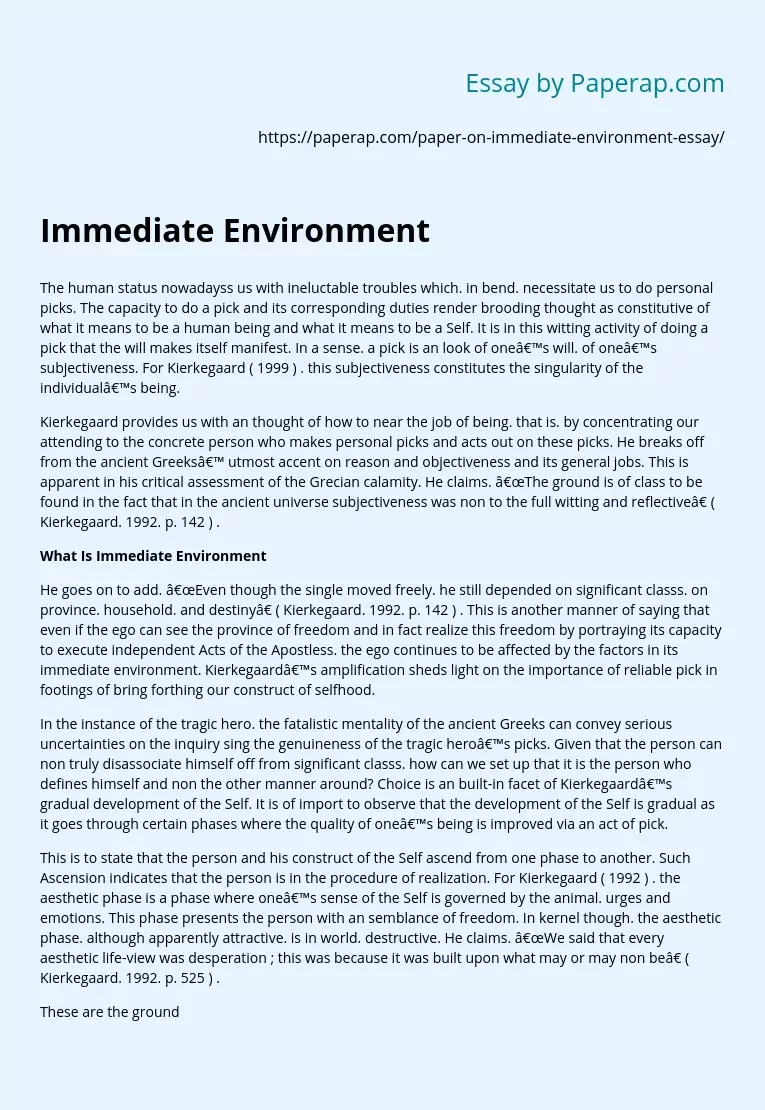What Is Immediate Environment
The following sample essay explains what the immediate environment is. To read the introduction, body, and conclusion of the essay, scroll down.
The human status nowadayss us with ineluctable troubles which. in bend. necessitate us to do personal picks. The capacity to do a pick and its corresponding duties render brooding thought as constitutive of what it means to be a human being and what it means to be a Self. It is in this witting activity of doing a pick that the will makes itself manifest.
In a sense. a pick is an look of one’s will. of one’s subjectiveness. For Kierkegaard ( 1999 ) . this subjectiveness constitutes the singularity of the individual’s being.
Kierkegaard provides us with an thought of how to near the job of being. that is. by concentrating our attending to the concrete person who makes personal picks and acts out on these picks. He breaks off from the ancient Greeks’ utmost accent on reason and objectiveness and its general jobs.
This is apparent in his critical assessment of the Grecian calamity. He claims. “The ground is of class to be found in the fact that in the ancient universe subjectiveness was non to the full witting and reflective” ( Kierkegaard. 1992. p. 142 ) .
He goes on to add. “Even though the single moved freely. he still depended on significant classs. on province. household. and destiny” ( Kierkegaard. 1992. p. 142 ) . This is another manner of saying that even if the ego can see the province of freedom and in fact realize this freedom by portraying its capacity to execute independent Acts of the Apostless.
the ego continues to be affected by the factors in its immediate environment. Kierkegaard’s amplification sheds light on the importance of reliable pick in footings of bring forthing our construct of selfhood.
In the instance of the tragic hero. the fatalistic mentality of the ancient Greeks can convey serious uncertainties on the inquiry sing the genuineness of the tragic hero’s picks. Given that the person can non truly disassociate himself off from significant classs. how can we set up that it is the person who defines himself and non the other manner around? Choice is an built-in facet of Kierkegaard’s gradual development of the Self. It is of import to observe that the development of the Self is gradual as it goes through certain phases where the quality of one’s being is improved via an act of pick.
This is to state that the person and his construct of the Self ascend from one phase to another. Such Ascension indicates that the person is in the procedure of realization. For Kierkegaard ( 1992 ) . the aesthetic phase is a phase where one’s sense of the Self is governed by the animal. urges and emotions. This phase presents the person with an semblance of freedom. In kernel though. the aesthetic phase. although apparently attractive. is in world. destructive. He claims. “We said that every aesthetic life-view was desperation ; this was because it was built upon what may or may non be” ( Kierkegaard. 1992. p. 525 ) .
These are the grounds as to why the aesthetic phase can non take to a progressive realization of the person. Apparently. it is besides the attraction and the emptiness of the sort of life in the aesthetic phase which leads the person to exceed animal being and ascend to the ethical phase. From reading Kierkegaard. it seems to me that the significant distinction between the aesthetic and the ethical person/stage remainders on the is-ought differentiation. Kierkegaard claims. “The aesthetic factor in a individual is that by which he is instantly what he is ; the ethical factor is that by which he becomes what he becomes” ( 1992. p. 492 ) .
The ethical individual is. hence. a individual who subscribes to the demands of ground ; and the ethical life is a life devoted to the chase of moral goodness. It is. nevertheless. of import to observe that Kierkegaard’s phrase “by which he becomes what he becomes” implies both committedness and pick on the portion of the person. The difference between Descartes and Kierkegaard is. at this point. really obvious. Descartes focal points on the expansive jobs of cosmopolitan import. such as being in its cosmopolitan sense. Kierkegaard ( 1992 ) . on the other manus. focal points on the concrete person and his concrete being.
In the terminal. it can be said that the construct of the Self is a merchandise of the concrete picks of the person as they present themselves in the class of the individual’s being. The realization of one’s Self requires something more than pick. that is. action. Aside from action. something more is required. that is. perpetrating oneself to the pick that he makes and his actions as a merchandise of one’s rational deliberation. Reference Kierkegaard. S. ( 1992 ) .
What Is Immediate Environment. (2019, Dec 05). Retrieved from https://paperap.com/paper-on-immediate-environment-essay/

